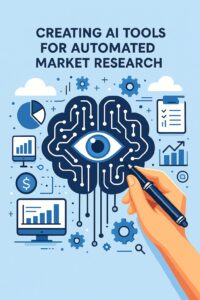In the world of business, understanding your audience is no longer optional—it’s a necessity. AI-powered market research tools are emerging as game-changers, automating processes, uncovering insights, and helping businesses make data-backed decisions faster than ever. But how are these tools developed? Let’s explore the step-by-step process of crafting AI-driven solutions for market research.

Transforming Market Research with AI
Traditional market research methods often involve manual analysis, which can be slow and prone to human error. AI tools redefine this by offering:
- Instant Data Analysis: AI processes enormous datasets in a fraction of the time.
- Future-Ready Forecasting: Machine learning predicts trends before they happen.
- Sentiment Understanding: AI deciphers consumer emotions from reviews and social media.
- Efficient Surveys: Intelligent systems gather feedback quickly with targeted questionnaires.
- Cost Savings: Businesses reduce reliance on manual research teams, cutting expenses.
This technological upgrade makes market research smarter, faster, and more reliable.
Tech That Powers Smart Market Research
Building these tools requires a blend of cutting-edge technologies and thoughtful integration. Here are some key components:
- Natural Language Processing (NLP): Enables AI to interpret written text like reviews, social media posts, and customer feedback.
- Machine Learning Models: Platforms like TensorFlow or PyTorch analyze data to identify hidden patterns.
- Sentiment Analysis Engines: Tools such as VADER and TextBlob specialize in detecting consumer tone—positive, neutral, or negative.
- Big Data Analytics Frameworks: Apache Hadoop or Google BigQuery helps manage and process massive datasets.
- AI-Driven Predictive Analytics: Frameworks like anticipate market trends, giving businesses a competitive edge.
These technologies combine to create robust, accurate tools for businesses to depend on.
Curating Data for AI Market Research
AI is only as good as the data it works with. Training your AI model requires a thoughtful, organized approach to data collection and preparation.
Essential Data Sources
- Online Reviews & Testimonials: Customer insights straight from their fingertips.
- Social Media Metrics: Engagement, likes, shares, and comments from platforms like Twitter and Instagram.
- Survey Results: User-submitted feedback providing first-hand perspectives.
- Competitor Performance Stats: Track rivals to understand what’s working for them.
- Industry Reports & Historical Data: Offer valuable context for predicting future trends.
Steps to Organize Your Data
- Clean Up: Remove irrelevant or duplicate data points.
- Focus on Key Metrics: Prioritize information like customer preferences, buying habits, and price sensitivity.
- Tag and Annotate: Organize datasets for tasks like classification or sentiment analysis.
- Ensure Compatibility: Merge data from diverse sources into a single, unified format.
With well-curated data, your AI tool can deliver actionable, trustworthy insights.
Training AI to Be Your Research Ally
Building an effective market research tool means training AI models to process data intelligently. Here’s how to fine-tune your system:
- Supervised Learning: Teach the model using pre-labeled datasets for accurate predictions.
- Unsupervised Analysis: Allow AI to explore patterns on its own for unique insights.
- Sentiment and NLP Training: Focus on tone detection, so the AI understands customer emotions.
- Iterative Refinements: Keep tweaking your models based on early-stage performance and feedback.
Trained properly, these systems can tackle everything from customer segmentation to competitor analysis.
From Development to Deployment
Building the tool is only part of the journey. Deployment ensures your system provides value where it’s needed most.
Smart Deployment Tactics
- Cloud Hosting: Provides scalability and flexibility for businesses of any size.
- Mobile Optimization: Ensure solutions are accessible on phones and tablets for researchers on the move.
- API Access: Let other tools—like CRM software—leverage your insights through seamless integration.
- Interactive Dashboards: Visualize data in real-time for quick decision-making.
Deployment should focus on usability and ensuring that insights are delivered seamlessly to the end user.
Making Your Tool Stand Out with SEO
To ensure your tool is discovered by the right audience, prioritize SEO best practices:
- Use Targeted Keywords: Incorporate terms like “AI-driven market research,” “predictive analytics for business,” and “automated insights tools.”
- Fast Load Times: Optimize your tool for quick performance across devices.
- Provide Educational Content: Write blogs, tutorials, and case studies about how your tool solves specific business problems.
- Build Partnerships: Work with market research agencies for credibility and outreach.
- Emphasize Metadata: Use concise, SEO-friendly titles and descriptions.
A strong SEO strategy ensures your solution is as visible as it is valuable.
Fine-Tuning the Experience
No tool is perfect from the start. Continuous improvement keeps your AI research tool relevant and effective.
Monitor These Key Metrics
- Prediction Accuracy: How well does it forecast trends or analyze feedback?
- User Interaction: Track adoption rates and satisfaction levels.
- Adaptability: Ensure the AI keeps pace with changing market dynamics.
- Error Reduction: Identify any flaws in data analysis or trend forecasting.
Ongoing optimization guarantees that the tool stays ahead of the curve.
Conclusion
AI-powered tools are revolutionizing market research by automating tedious tasks, providing instant insights, and allowing businesses to make informed decisions. From analyzing customer sentiment to identifying market trends, these tools open new possibilities for organizations of all sizes.
